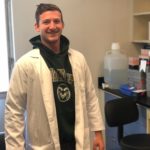The Tsunoda lab works on the plasticity of signaling in neurons. Current projects examine how neurons, synapses, and the whole animal adapt to hyper- and hypo- excitation of the system. Current projects investigate how ion channel and receptor expression and function change to protect neural signaling when confronted with changes that can occur during pathological conditions like seizure, stroke, or disease, as well as changes in sensory input that can overload a system. Using Drosophila melanogaster as our model system allows us to apply a wide variety of approaches to correlate recordings of activity by electrophysiology in the intact brain to genetic manipulations, and ultimately, to whole animal behavior.
The Tsunoda lab has a long-standing interest in creating a vibrant and collegial environment that is welcoming to students and researchers from all over the world. If you are an interested student, please email Dr. Tsunoda. In support of getting undergraduates familiar with research, Dr. Tsunoda also teaches a unique experiential research course, BMS 401: Laboratory Research in Biomedical Sciences.






